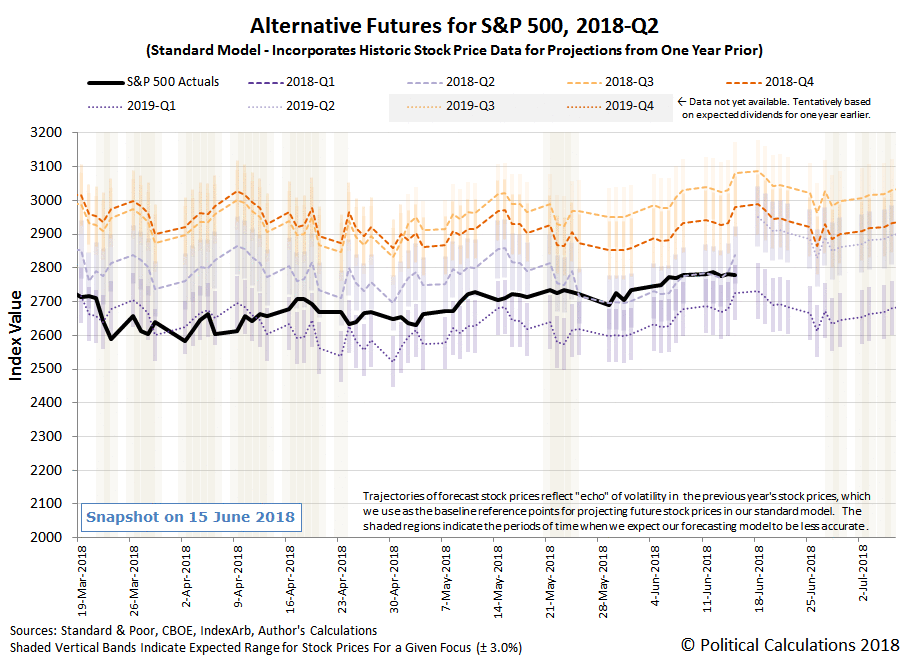The S&P 500 And The Tariff Dog That Didn't Bark
For all the news headlines about trade wars and tit-for-tat retaliatory tariffs, none of that trade-related news seems to be doing much to move the needle of the stock market.
We're not the only market observers to recognize that with little exception, the stream of trade-related news headlines isn't contributing much more than noise to the daily action of stock prices. Here's one such take:
Do you really think the treat of a trade war is causing U.S. stocks to stumble? That's what the headline writers would have you believe, but I'm not buying it.
It strikes me as though mounting trade tensions have become commentators' latest whipping boy, conveniently available as the after-the-fact explanation for whatever the market is already doing.
When the U.S. market tumbes, as it did Monday and again on Tuesday, when the Dow Jones Industrial Average fell by almost 300 points, increasing trade war worries are blamed. If the market had risen instead, any reports of easing trade tensions will undoubtedly receive credit.
And here's another similar take:
The escalating rounds of tariffs between the United States and China is an interesting point of economic debate. However, from the perspective of the interest rate markets, it appears to be one of those subjects that generates a great deal of economist commentary, but with limited market impact. This view is arguably complacent; whether it is too complacent is left for the reader to judge.
And there's more here. But let's go back to that first view that we quoted - would stock prices be behaving the way they are in the absence of such dueling trade headlines?
We may be able to answer that question. Last week, we observed that investors seemed to be fixing their forward-looking sights on the distant future quarter of 2019-Q1 in setting today's stock prices. Well, there's a particular trajectory on our S&P 500 spaghetti forecasting chart that's specifically projects the likely trajectory that the S&P 500 would follow within a relatively narrow range of error for that particular scenario, which we've projected prior to any news headlines being published for what would be the week ahead.
In the following animated chart, we've taken our chart from last week and are alternating it with the updated version from this week. Please click through to our site to see the animated version if you're reading this article on a site that republishes our RSS news feed.

What you see here is that if investors are indeed focusing on the distant future quarter of 2019-Q1 and the current expectations associated with it, the S&P 500 is behaving in accordance with that outlook, with U.S. stock prices falling within the typical range of noise that we would expect in that situation. As we noted two weeks ago, investors coming to focus upon 2019-Q1 would be associated with a downward movement in the S&P 500.
So without any advance knowledge of what the third week of June 2018's potentially market-moving news headlines might be, much less any trade war-related headlines, our dividend futures-based model of how stock prices work managed to account for the movement of the S&P 500 during the week. Before the week began.
Speaking of which, here are the headlines that we flagged as noteworthy during Week 3 of June 2018.
Monday, 18 June 2018
- Oil rises ahead of OPEC, China tariffs loom over U.S. prices
- Fed's Bostic: Economy in 'pretty good place' to let rate rises continue
- Wall Street ends modestly lower but energy shares rise
Tuesday, 19 June 2018
- Trade Wars:
- Oil slips on U.S.-China trade dispute, OPEC supply outlook
- Trade fears rattle Wall Street, Dow gives up 2018 gains
Wednesday, 20 June 2018
- U.S. crude jumps on stock draw; Brent slips ahead of OPEC meet
- U.S. home sales stumble as prices hit record high
- Fed's Powell says jobs market not too tight, repeats case for gradual rate hikes
- Nasdaq climbs to record; Dow capped by trade concerns
Thursday, 21 June 2018
- Oil falls as OPEC struggles for deal to raise output
- Supreme Court lets states force online retailers to collect sales tax
- Dow drops eighth straight session on trade worry; Amazon slips
Friday, 22 June 2018
Disclaimer: Materials that are published by Political Calculations can provide visitors with free information and insights regarding the incentives created by the laws and policies described. ...
more


